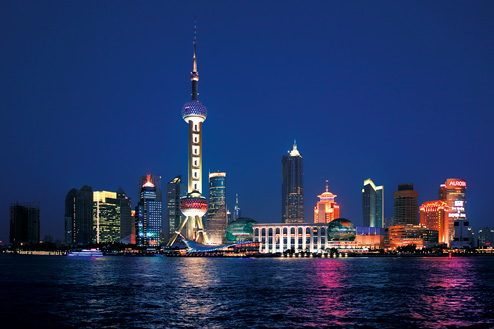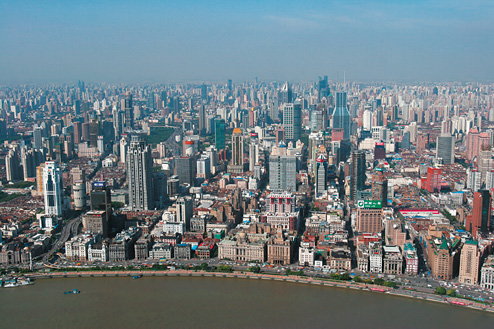Language
Shanghai’s official language is Mandarin Chinese (Putonghua). A notoriously difficult language to learn, it has no set alphabet and instead uses characters, a type of pictogram, which number at approximately 50,000. Luckily for Mandarin learners, not all are in everyday use and knowledge of about 3,000 should be enough to read a newspaper. Learning spoken Mandarin is made easier through the use of Pinyin, a system that uses the Roman alphabet to represent the pronunciation sounds.
Refrain, however, from breathing a sigh of relief, since spoken Chinese is a tonal language and, in itself, tricky to master. Each character is assigned one of five tones in the spoken form: first tone (high and level), second tone (rising from medium to high), third tone (starting low, dipping lower and then rising again), fourth tone (sharply falling from high to low) and the fifth neutral tone.
Characters with the same Pinyin ‘spelling’ have numerous meanings, each dependent on the particular tone used during pronunciation. A well-known but clear example of this potentially confusing aspect of spoken Chinese uses the word ‘ma’: pronounced with the first tone (mā) it means ‘mother’; with the second tone (má) it means ‘hemp’; with the third tone (mă) it means ‘horse’; with the fourth tone (mà) it means ‘to swear or reprimand’; and with the fifth tone (ma) it takes on the grammatical use of a question particle. A slip of the tonal tongue can, therefore, prove embarrassing.
In practice, the word on the city’s streets belongs to a far livelier local dialect: Shanghainese or Shanghaihua. Shanghaihua is derived from the Northern Wu dialect, one of 11 spoken across China. With no standardised written form, Shanghaihua exists only as an everyday spoken lingo and is hugely different in pronunciation to Mandarin. Fortunately, however, Mandarin is the official language of teaching in schools and can be understood and spoken by the great majority of Shanghainese.
There are a few potential pitfalls to be aware of, however. The Mandarin sound ‘shi’ is pronounced ‘si’ in Shanghaihua, meaning that any conversations relating to the numbers four (si) or 10 (shi) can be highly confusing if due care is not taken. The pronunciations of many other words are even further removed from their Mandarin counterparts: ‘hello, how are you?’ or ‘ni hao ma?’ in Mandarin becomes ‘nong ho ma?’ in Shanghainese, and ‘goodbye’ changes from ‘zaijia’ to an almost unrecognisable ‘zewei’.
For a foreign student of Mandarin this can pose serious comprehension problems. Regardless of whether you can understand or not, Chinese people greatly appreciate foreigners trying to learn the language and take such efforts as a sign of respect. Learning at least a few phrases is therefore a good way of ingratiating yourself with locals, particularly as many do not speak English.
In business or administrative situations, it is, however, advisable to stick to your native tongue. Starting off with the few Mandarin phrases that you have practised may give the impression you understand more than you do. Fortunately, as well as standard Mandarin, English is broadly accepted as the language of business in Shanghai, with countless firms hiring English teachers to train their Chinese employees. Many local restaurants and bars also cater to an ever-increasing expat population and now have bilingual menus. Venture outside these ‘safe-havens’, however, and you’ll be faced with page-upon-page of Chinese characters.
A lack of use of native English proofreaders means that numerous examples of ‘Chinglish’ can be found anywhere from shop signs to instruction manuals, many needing code-breakers to decipher. Luckily the majority of street signs avoid this trend and stick to Pinyin, making navigation of the city relatively easy.
Refrain, however, from breathing a sigh of relief, since spoken Chinese is a tonal language and, in itself, tricky to master. Each character is assigned one of five tones in the spoken form: first tone (high and level), second tone (rising from medium to high), third tone (starting low, dipping lower and then rising again), fourth tone (sharply falling from high to low) and the fifth neutral tone.
Characters with the same Pinyin ‘spelling’ have numerous meanings, each dependent on the particular tone used during pronunciation. A well-known but clear example of this potentially confusing aspect of spoken Chinese uses the word ‘ma’: pronounced with the first tone (mā) it means ‘mother’; with the second tone (má) it means ‘hemp’; with the third tone (mă) it means ‘horse’; with the fourth tone (mà) it means ‘to swear or reprimand’; and with the fifth tone (ma) it takes on the grammatical use of a question particle. A slip of the tonal tongue can, therefore, prove embarrassing.
In practice, the word on the city’s streets belongs to a far livelier local dialect: Shanghainese or Shanghaihua. Shanghaihua is derived from the Northern Wu dialect, one of 11 spoken across China. With no standardised written form, Shanghaihua exists only as an everyday spoken lingo and is hugely different in pronunciation to Mandarin. Fortunately, however, Mandarin is the official language of teaching in schools and can be understood and spoken by the great majority of Shanghainese.
There are a few potential pitfalls to be aware of, however. The Mandarin sound ‘shi’ is pronounced ‘si’ in Shanghaihua, meaning that any conversations relating to the numbers four (si) or 10 (shi) can be highly confusing if due care is not taken. The pronunciations of many other words are even further removed from their Mandarin counterparts: ‘hello, how are you?’ or ‘ni hao ma?’ in Mandarin becomes ‘nong ho ma?’ in Shanghainese, and ‘goodbye’ changes from ‘zaijia’ to an almost unrecognisable ‘zewei’.
For a foreign student of Mandarin this can pose serious comprehension problems. Regardless of whether you can understand or not, Chinese people greatly appreciate foreigners trying to learn the language and take such efforts as a sign of respect. Learning at least a few phrases is therefore a good way of ingratiating yourself with locals, particularly as many do not speak English.
In business or administrative situations, it is, however, advisable to stick to your native tongue. Starting off with the few Mandarin phrases that you have practised may give the impression you understand more than you do. Fortunately, as well as standard Mandarin, English is broadly accepted as the language of business in Shanghai, with countless firms hiring English teachers to train their Chinese employees. Many local restaurants and bars also cater to an ever-increasing expat population and now have bilingual menus. Venture outside these ‘safe-havens’, however, and you’ll be faced with page-upon-page of Chinese characters.
A lack of use of native English proofreaders means that numerous examples of ‘Chinglish’ can be found anywhere from shop signs to instruction manuals, many needing code-breakers to decipher. Luckily the majority of street signs avoid this trend and stick to Pinyin, making navigation of the city relatively easy.













